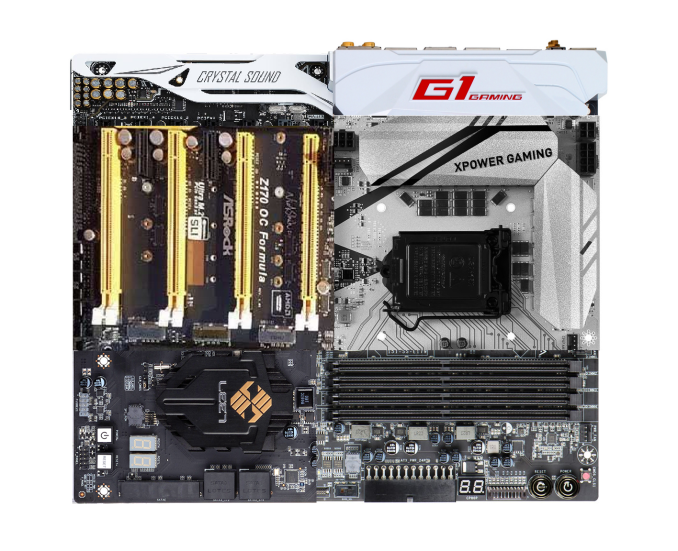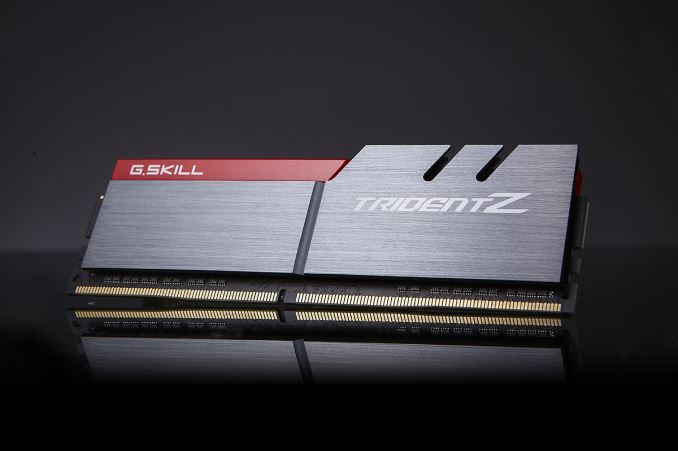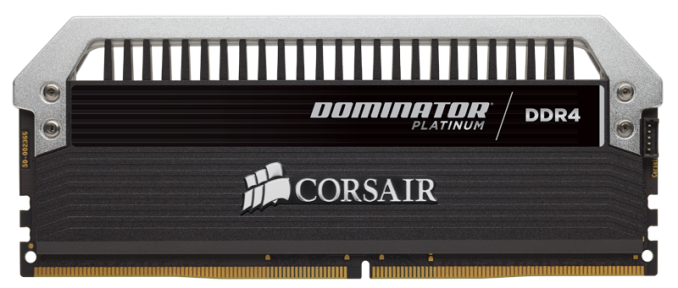The Intel 6th Gen Skylake Review: Core i7-6700K and i5-6600K Tested
by Ian Cutress on August 5, 2015 8:00 AM ESTAlso Launching Today: Z170 Motherboards, Dual Channel DDR4 Kits
The new Skylake processors are assigned a new socket – LGA1151. Intel’s policy since 2006 has been to maintain sockets for two generations and as a result moving from Broadwell to Skylake we were expecting the change. This means that Skylake processors will not work in LGA1150 based motherboards, i.e. those with Intel’s 8th and 9th generation chipsets. For Skylake we get the 100-series chipsets with additional functionality. Launching today in turn is the first member of the 100-series family, the overclocking-friendly Z170, with the other chipsets in the family to follow later in the year.
We have a large piece on the motherboards being released or talked about for Skylake, covering some 55+ products and the different variations within. The major motherboard manufacturers such as ASUS, GIGABYTE, ASRock, MSI, EVGA and a couple of others should all have a wide range ready to purchase on day one, although some models may be region specific.

The badly MSPaint’ed hybrid: MSI’s XPower Gaming Socket, GIGABYTE’s G1 Gaming IO panel, EVGA’s DRAM slots, ECS’s chipset, ASRock’s PCIe arrangement and ASUS’ Deluxe audio.
Here’s an amalgamation of some of the designs coming to end users, with almost all of them investing heavily in gaming brands with specific components to aid the user experience while gaming. Aesthetic designs are also going to be a focus of this generation, with some of the manufacturers moving into a different direction with their designs and trying some new color schemes. Some basic looking models will also be available.
Prices for Z170 motherboards will range from $80 all the way past $400+, depending on feature set and size. A number of motherboards above $150 will feature a couple USB 3.1 Gen 2 (10Gbps) ports, although you will have to check whether they are Type-A or Type-C. That being said, most motherboards with USB 3.1 will use both, but there are a select few that are C-only or A-only. Also over $150 we will see a lot of Intel’s new network controller, the I219-V, although the gaming lines might invest in Rivet Network’s Killer solution instead.
Intel is launching the Alpine Ridge controller at this time as well, which is said to support USB 3.1 Gen 2, Thunderbolt 3, HDMI 2.0, DisplayPort, and DockPort. According to our sources it would seem that GIGABYTE currently has an exclusive on this technology, and it will be used for their USB 3.1 Gen 2 ports on most motherboard models. Other functionality from the Alpine Ridge controller (TB3, HDMI 2.0) will be on a case-by-case basis depending on how the controller works in two different modes or if extra components are used. We are told that Alpine Ridge costs similarly to the ASMedia ASM1142 controller, but will enable two USB 3.1 Gen 2 ports at 10 Gbps simultaneously as it uses four PCIe lanes from the chipset.
We will go more into the 100-series chipset in the next page, but it is worth mentioning briefly here that the speed between the CPU and the chipset has increased from DMI 2.0 (5 GT/s, 2GB/sec) to DMI 3.0 (8 GT/s, 3.93GB/sec), and that the chipset has a new high speed hub (HSIO) that allows 26 lanes to be used from it although some lanes are limited (e.g. 20 PCIe 3.0 lanes maximum split into five x4 controllers). Intel’s Rapid Storage Technology is upgraded as well to give three PCIe drives access to its features as long as they are on the correct HSIO ports.
DRAM: The March to DDR4
In the world of DRAM for personal computers, DDR3 is currently king. Having been the main standard since 2007, you would be hard pressed to find a mainstream or low end platform sold that did not require access to DDR3. That changed in the enthusiast segment last year with the launch of Haswell-E which also introduced DDR4 at a high premium. For Haswell-E there was no crossover – you had no choice but to use DDR4 (unless you might be a million-unit customer).
Because the consumers and consumer product OEMs are more price sensitive, DDR4 will be a slower transition. There is precedent here in that the move from DDR2 to DDR3 saw a generation of processors that supported both standards and it was up to the motherboard manufacturer to design for it. In this transition, Skylake processors will support both DDR3L and DDR4 modules, with a few caveats.
Caveat number one is that initially, only DDR4 motherboards will be on the market. So if you upgrade now, DDR4 needs to be on the shopping list as well. We have had word of some DDR3L-only motherboards coming, as well as combo boards with DDR3L and DDR4 slots on board. Caveat one-point-five, you can use either DDR3L or DDR4, but not both at the same time.
Caveat number two, DDR3L is different to DDR3 as it operates at a lower voltage. This means that the memory controllers on Skylake most likely have a combined voltage domain, and regular DDR3 might not work (in fact early testing suggests not without reducing the voltage). Very few people currently own DDR3L DIMMs, so the likelihood of a user performing an upgrade while reusing their RAM might be slim.
Caveat number three: prices of DDR4 have dropped significantly since last year, and there is only a small premium over DDR3. The benefits of DDR4 include a lower operating voltage, a more stable design, and the ability to purchase 16GB modules with ease. That means that a Skylake platform will happily take 64GB of memory.
With that last point, we should point out that Skylake is a dual memory channel architecture, supporting two memory modules per channel. This gives a maximum of four DDR4 tests, and 4x16 = 64GB maximum.
We have been told that Skylake’s memory controller, compared to previous generations, is absolutely golden at higher speed memory support. By default Skylake supports the JEDEC standard for DDR4, 2133 MT/s at a latency of 15-15-15, but the overclocking guides we have received suggests that all processors should be able to reach DDR4-3200 relatively comfortably, with a few processors in the right motherboards going for DDR4-4000. While this should bode well for integrated graphics users, those high end kits are typically very expensive.
We currently have dual channel kits in to test from a number of the DRAM companies, and plan on performing a memory scaling article within the next few weeks to see how exactly performance might scale on Skylake. Though in the meantime, as part of this review, we were able to source a closed beta variant of a combination DDR3L/DDR4 motherboard for Skylake and have included a test comparing the two.












477 Comments
View All Comments
watzupken - Friday, September 4, 2015 - link
To be honest, I feel the recent AMD chips are not so bad. From my opinion it boils down to 2 things,1) They are not able to get software makers to optimize for their chips,
2) Disadvantage in terms of fab, i.e. 28nm vs 20/14nm.
Of course, they also don't have a pocket a deep as Intel to begin with. So any misstep can have a serious setback for them.
i_will_eat_you - Saturday, December 12, 2015 - link
AMD is long dead especially for the desktop market and server market. For their latest highend chips they simply slap bigger and bigger fans/heat sinks on to deal with a higher TDP from a ramped up clock. I'm not even sure if they have a particularly good standing in the "APU" market, low end market, etc. ARM and Intel are doing much better.They only have a slight gain in the GPU market with the push of HBM but even this does not give them a strong lead and they are falling onto Apple like marketing in attempt to boast their sales.
The only reason people might tolerate AMD at the moment is because a lot of tasks will run ok on a CPU that is not the best or not the best value for money.
Until they release a new architecture and a new fabrication process they are becoming completely out of the game. I agree they have no room for error in that.
Synomenon - Monday, August 24, 2015 - link
So it's possible to have the full 16 PCIe 3.0 lanes from the CPU going to the GPU and have 4 PCIe 3.0 lanes from the chipset going to the m.2 drive on a Z170 board?wyssin - Sunday, August 30, 2015 - link
Here's what I'm talking about.In their i7-6700K review article, bit-tech.net compared chips at stock settings AND at a decent overclock. By seeing both of those results, you can see whether an upgrade makes sense for your needs (assuming you are an overclocker).
http://www.bit-tech.net/hardware/2015/08/05/intel-...
oranos - Tuesday, September 15, 2015 - link
Looks like after 5 years, there is still no reason to upgrade a 2500k.sheeple - Thursday, October 15, 2015 - link
I TOTALLY agree with yousheeple - Thursday, October 15, 2015 - link
THIS is funny, I'm using a SUPER OOOOOOLD L5408 Xeon that sips 40 watts and gives the performance of a 4th. gen i3 and runs ALL the latest 2015 games and the L5408 cost me 40 bucks on ebay, HAHAHAHAHAAAAA!!!!sheeple - Thursday, October 15, 2015 - link
My L5408 isn't even overclocked past 2.76 Ghz and runs The Witcher 3 Wild Hunt (game from 2015 on a machine with a cpu and mobo that together cost me 70 bucks used-the cpu was introduced in beginning of 2008) at 30 fps AVERAGE WITH ALL SETTINGS MAXED @ 1080p using a STOCK GTX 950 LOL!!! Whoever buys one of these "Skynet" Cpu's needs to do more research, SERIOUSLY !!!!sheeple - Thursday, October 15, 2015 - link
DON'T BE STUPID SHEEPLE!!! NEW DOES NOT ALWAYS = BETTER!manolaren - Saturday, October 31, 2015 - link
So if Anandtech tests are accurate, between the skylake cpu's, i5 is the way for a gaming pc. Gaming benchmarks are almost identical, but the price is a lot cheaper for the i5. Considering skylake doesn't bring nothing groundbreaking for the genre, then i cant see any other way for gamer's. My only question is if future games will take advantage of more than 4 cores and make i7 cpu's a must.